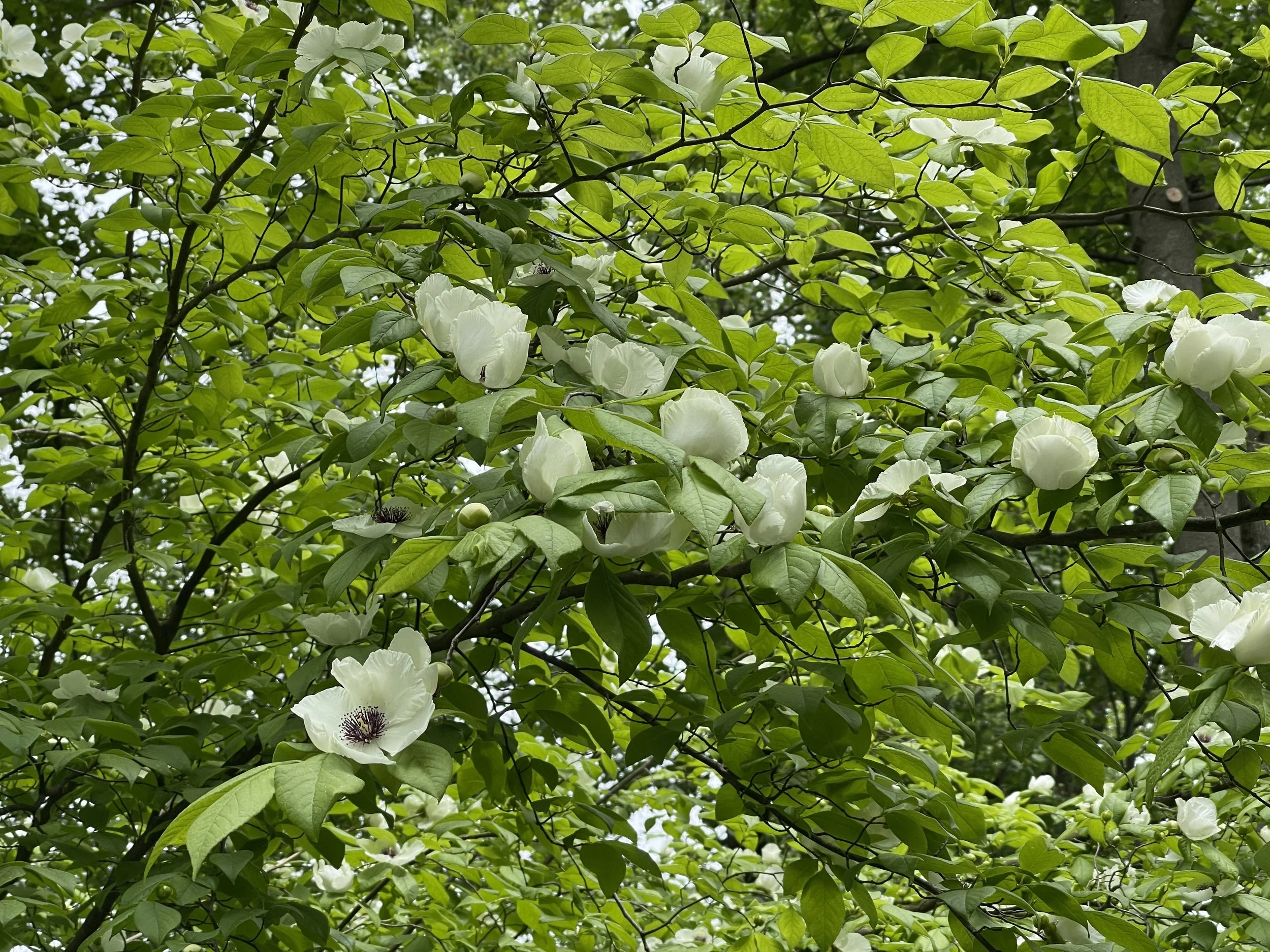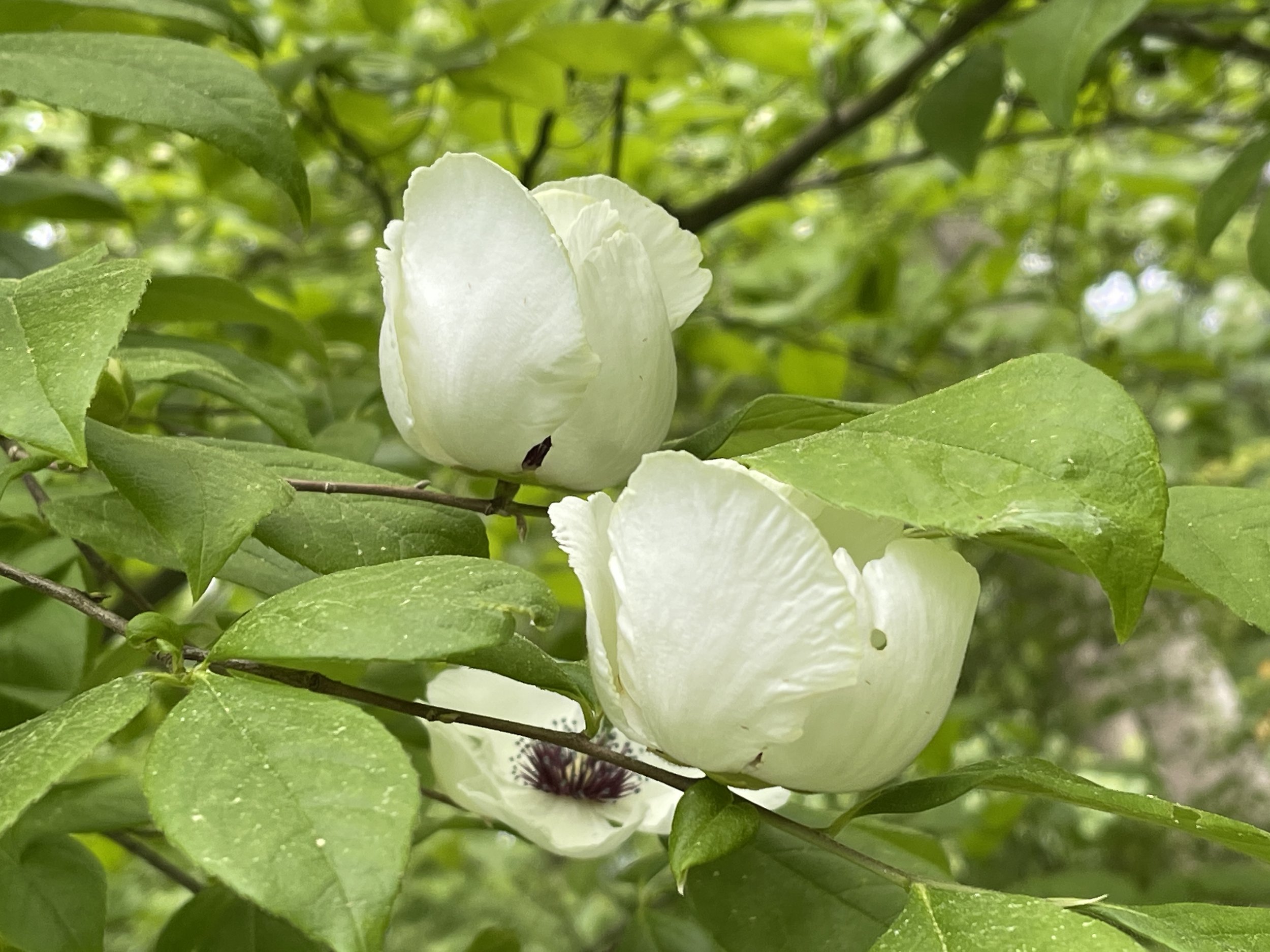Why is no one growing and selling this extraordinarily beautiful native tree?

On a visit to Mount Cuba Center several days ago, we came upon this stunner. My friend Giacomo, who’s vacationing from London, speculated it might be a Stewartia, though not one he’d ever seen.
Stewartia malacodendron
My memory doesn’t usually work for plant names read years ago, but for some reason the word “malacodendron” echoed vaguely in my brain, though not firmly enough to make an identification. Giacomo asked a staff person nearby, who responded “native Stewartia,” not quite specific enough. (Why can’t Americans realize the botanical names of plants are essential!)
Another staffer came by and confirmed it for us: Stewartia malacodendron.
It seems this beautiful native tree just isn’t available in the trade. Why? (Fortunately, seed seems to be available from various small suppliers on the internet.)
Here’s a bit of what I found in a quick search. Note that most of what I quote below identifies this as a “southern” tree. That’s not an absolute. Brian McGowan, formerly of Polly Hill Arboretum on Martha’s Vineyard, reports on my Instagram feed (imfederaltwist) that he has grown it successfully from seed, and that several beautiful specimens are growing on the campus of Smith College in Northampton, Massachusetts. Polly Hill’s website reports it to be hardy in zone 6 (if sited appropriately, of course).
‘We are in Zone 5,’ McGowan writes, ‘the Berkshires of western Massachusetts. I planted my plants here 5 years ago as one year seedlings and they have been growing well. I thought being north of their usual habitat that they may need/tolerate more sun which is where I planted them. They grew but did not look entirely happy so I moved them to more shade and they look great. We had a hard freeze here two weeks ago and there were quite a few native and non native species that had lost all new growth. Interestingly the S. malacodendron suffered no damage at all. Hope this encourages you to give them a try.’
NC State Extension
‘The silky camellia is a beautiful flowering deciduous shrub or small tree that is native to North Carolina. This particular species tends to occur more in the coastal plain. Another native, known as the mountain camellia, is found in the Piedmont and the Appalachian Mountains. The silky camellia may reach a height of 10 to 18 feet and has wide-spreading branches. The plant is a member of the Theaceae family and is related to the Camellia. The white Camellia-like flowers and the cinnamon-colored exfoliating bark are eye-catching in a woodland setting.
The silky camellia is native to the Southeastern United States and the Gulf Coast, but it may be rarely seen. The plant may be found as an understory tree in woodland areas or along ravines, streams, and creeks. The Department of Natural Resources has reported that in the State of Georgia, the plant is "imperiled" with only nine confirmed sightings since 2000. It is also vulnerable in Alabama, and there are rare sightings in east Texas.
The genus's name, Stewartia, is in honor of John Stuart who was a 16th-century Scottish botanist. The spelling was the result of a transcription error. During the 19th-century, the name Stuartia was used; however, the original spelling is now accepted. The species name, malacodendron, is Greek and means "soft tree." This refers to the silky hairs on the undersides of the leaves.
The silky camellia prefers rich loamy, moist, well-drained soils, and the shelter of woodlands. The plant thrives in the morning sun but needs deep shade during the hottest part of the day. They are difficult to transplant. Propagation methods include seeds, softwood cuttings, or semi-hardwood cuttings. Pruning is not needed except to remove diseased or damaged limbs.
The white Camellia-like flowers have centers of purple stamens and blue anthers. The bark is smooth cinnamon color and exfoliates in strips. Silky hairs are found on the undersides of the dark green leaves and the young reddish-brown twigs. The fruit is a small oval capsule.
Consider the silky camellia as an accent or specimen in a shaded and sheltered cottage garden or woodland setting. Be aware that it has been known to be difficult to cultivate and does not like to be disturbed.
Light:
Deep shade (Less than 2 hours to no direct sunlight)
Partial Shade (Direct sunlight only part of the day, 2-6 hours)
Soil Texture:
High Organic Matter
Loam (Silt)
Sand
Soil pH:
Acid (<6.0)
Neutral (6.0-8.0)
Soil Drainage:
Good Drainage
Moist
NC Region:
Coastal
Mountains
Piedmont
USDA Plant Hardiness Zone:
7b, 8a, 8b, 9a’
https://plants.ces.ncsu.edu/plants/stewartia-malacodendron/
USDA website - Silky Camellia (Stewartia malacodendron L.)
By Ken L. Gordon, Botanist National Forests in Mississippi
‘While not a true camellia, the silky camellia is a distant relative and when in flower, attracts attention like few other native shrubs. The striking flower with its five white petals and numerous blue-purple stamens remind one of its distant relative, the Japanese Camellia. When not in bloom, the silky camellia is often overlooked. Many who frequent the woods in which this species occurs have no idea such a thing is present. Silky camellia is a shrub or small tree (growing to as tall as 7 meters). The branches are widely spreading, often with multiple stems. The branches diverge horizontally such that the leaves and twigs appear to be in one plane. The leaves are simple and alternate, ovate to elliptic with acute tips. The leaves are 5-10 cm long and 3-5 cm broad. The large and showy petals are on short stalks that lift them above the plane of the leaves. Silky camellia can be identified in any season by the broad spreading branches with twigs all in one plane and by the elongate silky-pubescent buds.
Stewartia malacodendron grows mostly on the coastal plain from southeastern Virginia, down the Atlantic Coast through North Carolina, South Carolina, and Georgia. The species’ range then turns westward along the Gulf Coast from the Florida panhandle, north-central and southern Alabama, southern Mississippi, west to the Mississippi River, and in adjacent parishes of Louisiana. There are disjunct populations in south-central Arkansas and east Texas.
The species is found as an understory plant in rich wooded bluffs, ravine slopes and creek banks. While always uncommon throughout its range, the range is widespread. Silky camellia does not form large stands but typically occurs as 3-10 localized plants, often associated with small trees of witch hazel.
Because of the interesting branching pattern and showy white flowers, the plants are sometimes cultivated in native plant gardens. Those who work with the species have found silky camellia to more than a little difficult to maintain and reproduce. The plant has a reputation for being short-lived and finicky as to site tolerance. However, for the southern gardener willing to learn how to work with the plant, few will deny that a properly sited mature specimen in bloom is one of the most beautiful native species of the south.’
https://www.fs.usda.gov/wildflowers/plant-of-the-week/stewartia_malacodendron.shtml
So why is this tree not available in the trade? It’s not easy to propagate, can be difficult to grow successfully, and is potentially short-lived. But does that stop people from growing the Franklinia?






